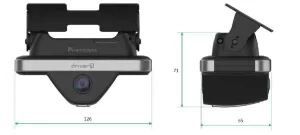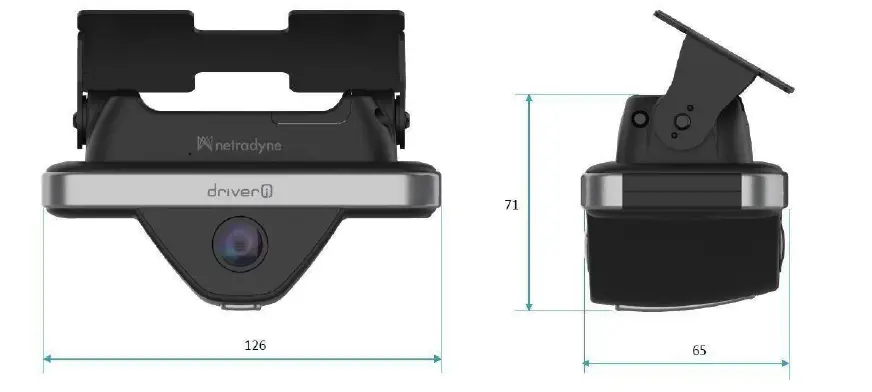

netradyne D210 Fleet Dash Camera

Driveri™isan AIpoweredvisionbasedIoTsystem,soldasanaftermarketproducttofleets. The device is installed in trucks/cars behind the rear-view mirror, and the power is supplied from the car battery through a custom power cable.
When the vehicle is being driven, the road facing camera is enabled by default, records and generates real time safety alerts to assist the driver. The camera facing the driver / passenger is optional due to privacy requirements and enabled at customers’ request. The recorded videos are processed (using our patented machine learning algorithms) on the device together with the other sensor data and can detect any events related to driving behaviour and driver behaviour. The device has 2 buttons on the bottom side of the device, when pressed creates alerts which are user generated. 2 LEDs on driver facing side indicate the current operational state of device & also indicate privacy setting (driver facing camera recording status).
Features
- Octacore CPU + GPU / DSP for Edge computing
- Auto-grade ISP with 90+ dB of HDR performance and Full HD imaging
- Full HD Inward /driver facing camera with IR LED for night vision
- Connectivity – WiFi / BT
- 2 LED indicators to represent device state
- Integrated Mic & Speaker for alerts
- 2GB RAM + 64GB ROM, expandable up to 256GB
- Inertial sensors (Accelerometer & Gyro), Thermal sensor
Processor Specifications |
||
| CPU | 64-bit ARM® Octa Core | |
| Video Encoding – H.265 | 1080p | |
| Video format | HD Videos for limited time (customizable) Low Resolution videos for long term storage | |
| Sensors | IMU – Accelerometer + Gyro, Temperature, Ambient Light | |
RAM and Storage |
||
| Storage | 64GB / 128GB eMMC | |
| Expandable Storage | Up to 256GB via microSD | |
Camera Specifications |
||
| Camera | Outward | Inward |
| Pixel Size | 2.8μm OmniBSI-2 pixel | 3μm x 3μm |
| Dynamic Range | >90dB HDR | 72db |
| Field of View | 74° (Horizontal)
57° (Vertical) 90° (Diagonal) |
148° (Horizontal)
80° (Vertical) 168° (Diagonal) |
| Construction | 6G – Visible | 6G + IR Filter (Dual Band) |
Wireless Connectivity and I/O |
||
| Wi-Fi | 802.11 b/g/n | |
| Bluetooth | V5.0 |
| Connectors | USB (with OTG support), Power Jack, microSD |
Electrical Specifications |
|
| Input Voltage | 7V-17V |
| Input current (full operation) | 12V / 2A |
| Max Power Consumption | 24W |
| Signals Input – High Voltage
(Positive) |
+17V |
| Signals Input – Low Voltage
(Negative) |
0v |
Physical Dimensions |
|
| Length x Width x Height | 126mm x 71mm x 65mm |
| Colour | Black |
| Case Material | Polycarbonate (PC) |
| Power Cable Length | 3 meters |
| Power Cable Thickness | 4.5mm |
OPERATING REQUIREMENTS AND CONDITIONS
The design of Netradyne D-210 complies with U.S. Federal Communications Commission (FCC) guidelines respecting safety levels of radio frequency (RF) exposure for Mobile devices.
RF Radiation Exposure Statement
This equipment complies with FCC RF radiation exposure limits set forth for an uncontrolled environment. This equipment should be installed and operated with a minimum distance of 20 centimetres between the radiator and your body.
FCC PART 15 STATEMENT
This device complies with Part 15 of the FCC Rules. Operation is subject to the
following two conditions:
- this device may not cause harmful interference, and
- this device must accept any interference received, including interference that may cause undesired operation.
This equipment has been verified to comply with the limits for a class B computing device, pursuant to FCC Rules. In order to maintain compliance with FCC regulations, shielded cables must be used with this equipment. Operation with non-approved equipment or unshielded cables is likely to result in interference to radio and TV reception. The user is cautioned that changes and modifications made to the equipment without the approval of manufacturer could void the user’s authority to operate this equipment.
This equipment has been tested and found to comply with the limits for a Class B digital device, pursuant to part 15 of the FCC Rules. See 47 CFR Sec. 15.105(b). These limits are designed to provide reasonable protection against harmful interference in a residential installation. This equipment generates, uses and can radiate radio frequency energy and, if not installed and used in accordance with the instructions, may cause harmful interference to radio communications. However, there is no guarantee that interference will not occur in a particular installation. If this equipment does cause harmful interference to radio or television reception, which can be determined by turning the equipment off and on, the user is encouraged to try to correct the interference by one or more of the following measures:
- Reorient or relocate the receiving antenna.
- Increase the separation between the equipment and the receiver.
- Connect the equipment to an outlet on a circuit different from that to which the receiver is connected.
- Consult the dealer or an experienced radio/TV technician for help.
REGULATORY INFORMATION
- Model name: Netradyne D-210
- Series Model: D-210A, D-211
- FCC ID: 2AM8R-D210 company number 23098
- IC : 23098-D210
FCC CAUTION STATEMENT FOR MODIFICATIONS
- CAUTION: Any changes or modifications not expressly approved by Netradyne could void the user’s authority to operate the equipment.
IC Caution:
This device contains license-exempt transmitter(s)/receiver(s) that comply with Innovation, Science and Economic Development Canada’s licence-exempt RSS(s). Operation is subject to the following two conditions:
- This device may not cause interference.
- This device must accept any interference, including interference that may cause undesired operation of the device.
RF exposure statement:
The equipment complies with IC Radiation exposure limit set forth for an uncontrolled environments. This equipment should be installed and operated with minimum distance 20cm between the radiator and your body.
Warning
A vision-based platform designed to enhance driver safety within the commercial vehicle market, Driveri™ focuses on identifying, recognizing, and rewarding positive driver performance. The platform was developed to capture every moment of the driving experience, delivering stronger value to each driver, fleet manager, and a fleet’s bottom line. It does not replace the role of the driver nor the functions a driver ordinarily performs. It does not eliminate or decrease the need for a driver to stay alert and to obey all traffic laws while operating a vehicle. Driveri is not an automated driving assistance program and it does not act as a substitute for any aspect of driver vehicle control or safe driving practices. Whether or not the device is in use, it is always the responsibility of the driver to take appropriate corrective action. The driver should never wait for the Driveri program to provide a warning or coaching opportunity before taking measures to avoid an accident. Failure to do so can result in serious personal injury, death, or severe property damage.
While Driveri uses machine vision learning, artificial intelligence, and algorithms, it cannot and does not guarantee 100% accuracy in the detection of street signs, other vehicles, traffic lights, driving lanes, pedestrians, weather conditions, nor in providing warnings of all potential road hazards. Drivers should never solely rely on Driveri, but instead should rely on safe driving practices and maintain control of the vehicle at all times.
Driveri may have limited to no functionality in certain conditions such as inclement weather, low visibility, and certain road conditions. Always keep the cameras and view of the device unobstructed and properly calibrated so as not to inhibit the functionality of Driveri. Driving in certain conditions or any interference with the device can result in false, few, or no alerts.